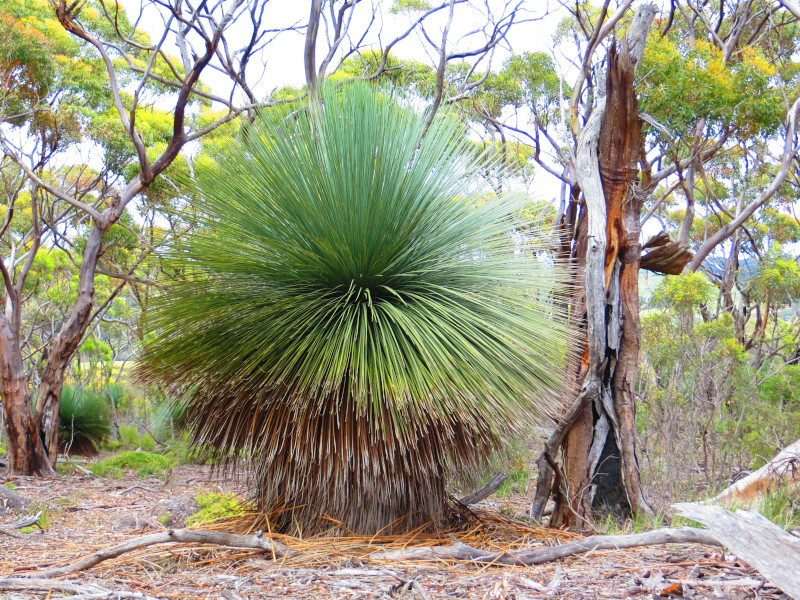
Tufted Grass Tree Facts
- This distinctive product of Nature and evolution most frequently goes by the descriptive common name of the Tufted Grass Tree. For the moment, it has no other broadly accepted general title. While certainly not unknown, it’s certainly uncommon.
- Within the scientific community, however, it’s perhaps better known by its technical designation. Unfortunately, that’s an extremely difficult appellation for the layperson to pronounce. That’s because it holds the formal tag Xanthorrhoea semiplana.
- The botanical wonder received that tongue-twisting moniker due to the efforts of Sir Ferdinand Jacob Heinrich von Mueller. The German-Australian botanist accomplished the first recognition of it as a separate and distinct species. He managed that in 1864.
- Interestingly, a known total of two subspecies of the amazing plant exist. Those include the Kangaroo Island Grass Tree, shown in this image. The other, though, is the one more often referred to when speaking of the species. This often creates confusion.
- Thankfully, the fabulous Tufted Grass Tree appears to be maintaining a population base that’s both stable and sufficient. That pleasant state also seems to hold true across its entire range. The IUCN therefore currently lists the unusual flora as Least Concern.
- The plant should nevertheless be considered as facing the same overall threats to its existence as all forms of life on this planet. Most of those stem from the actions of mankind. They include the related perils of habitat loss and ongoing climate change.
Related Articles
Tufted Grass Tree Physical Description
The remarkable Tufted Grass Tree typically generates a great deal of appreciation from those fortunate enough to view it. This further holds true for both subspecies of the natural wonder. Yet, they do so in varying ways, since the two present different looks.
The one referred to commonly as the Kangaroo Island Grass Tree generally ranks as the taller of the two subspecies. This occurs due to the fact that, unlike the other, it possesses a trunk. That feature of the flora typically attains a height measuring roughly 3.3 ft (1 m).
Meanwhile, the better known form of the Angiosperm has no trunk. Its main body therefore begins very close to the ground. From this point upward, however, both versions of this extraordinary plant present the same basic physical characteristics to the viewer.
It’s the leaves of the Tufted Grass Tree that usually garner the most attention, though. Each of these develops as highly elongated and thin in structure. This foliage presents a stiff nature, and has a greenish-blue color. Each leaf ranges in length from 3.3 – 9.8 ft (1 – 3 m).
When its gorgeous blooms appear, these also catch the eye. The flowers develop atop tall spikes, also measuring approximately the same height range as the leaves. In color, the amazing plant’s blooms most frequently present a beautiful light cream shade.
- Kingdom: Plantae
- Phylum: Tracheophyta
- Class: Monocots
- Order: Asparagales
- Family: Asphodelaceae
- Genus: Xanthorrhea
- Species: X. semiplana
Tufted Grass Tree Distribution, Habitat, and Ecology
The intriguing Tufted Grass Tree evolved as indigenous to a relatively small swathe of the surface of the earth. Given its unusual nature, the location of that zone of habitation likely won’t surprise many people. It evolved as native to a specific section of Australia.
Even there, though, it only makes its home naturally on a small portion of the continent. That’s the general southeastern section of the landmass. That includes such regions as the Yorke, Eyre, and Fleurieu Peninsulas. It’s also obviously present on Kangaroo Island.
Within that somewhat restricted habitat range, though, the plant proves itself to be reasonably flexible in terms of its choice of habitat. It therefore appears in several different ecosystems. Most of these settings do, however, maintain a Mediterranean-type climate.
The botanical marvel often lives in temperate forest regions. Yet, it also does equally well in areas of moderately dry conditions. This frequently includes such locations as areas of plains or desert dunes. It also lives at altitudes from sea level to low-level mountains.
In all sections where it lives, though, the awesome Tufted Grass Tree plays a surprisingly important role in the local environment. Many species, including lizards and mammals, find shelter within its cluster of leaves. The same structure also provides relief from the heat.
Its usefulness hardly ends there, however. Many animals consume the numerous leaves of the plant. Others, such as some avians feed on the seeds of the blooms when the develop. The sweet nectar of those same flowers additionally nourishes many other birds.
Species Sharing Its Range
Check out our other articles on 4 Marvelous Mammals of Madagascar, Serval, Southern Stingray, Komodo Island, Fire Salamander, Scarce Swallowtail, Indian Vulture, Philippine sailfin lizard
